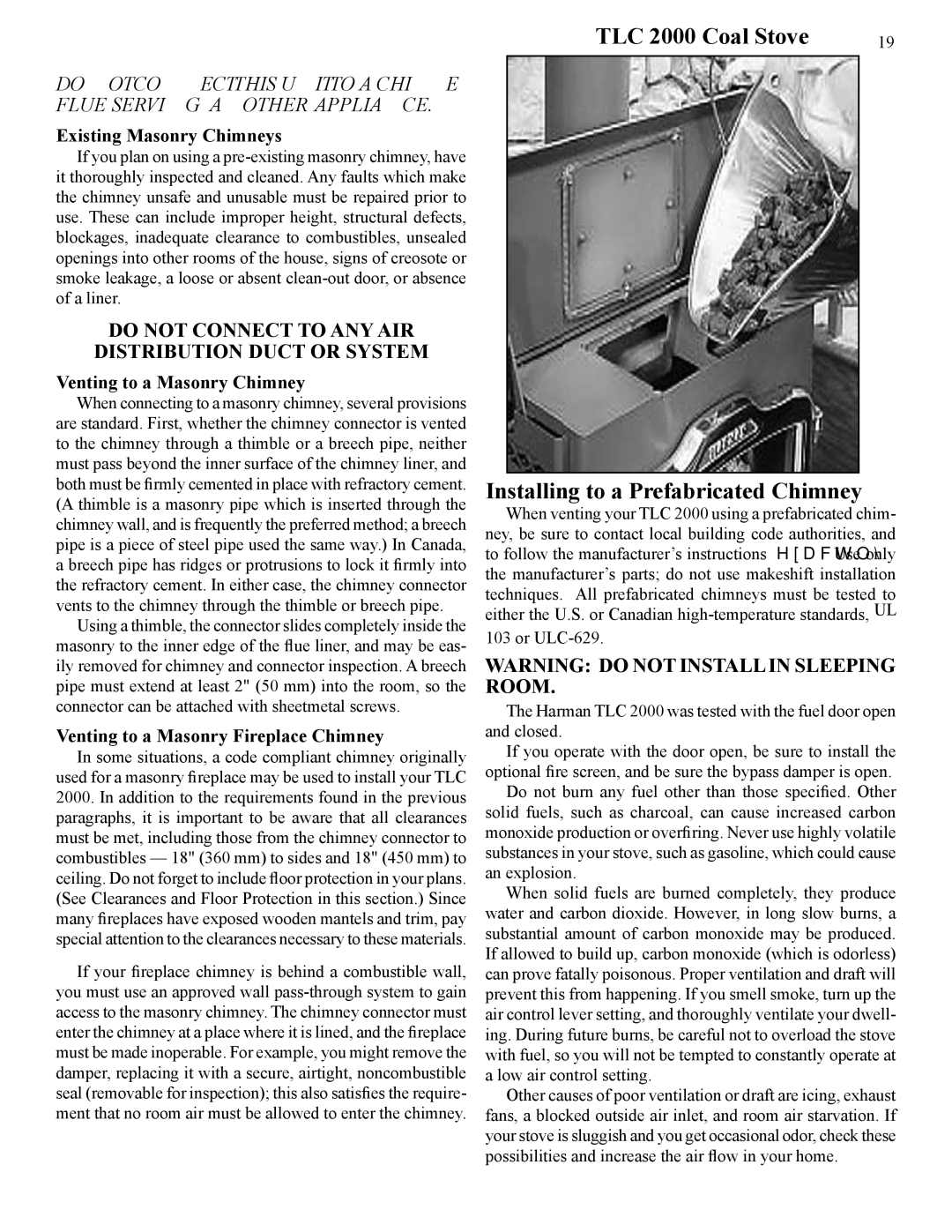
Do not connect this unit toachimney flue serving another appliance.
Existing Masonry Chimneys
If you plan on using a
Do not connect to any air distribution duct or system
Venting to a Masonry Chimney
When connecting to a masonry chimney, several provisions are standard. First, whether the chimney connector is vented to the chimney through a thimble or a breech pipe, neither must pass beyond the inner surface of the chimney liner, and both must be firmly cemented in place with refractory cement. (A thimble is a masonry pipe which is inserted through the chimney wall, and is frequently the preferred method; a breech pipe is a piece of steel pipe used the same way.) In Canada, a breech pipe has ridges or protrusions to lock it firmly into the refractory cement. In either case, the chimney connector vents to the chimney through the thimble or breech pipe.
Using a thimble, the connector slides completely inside the masonry to the inner edge of the flue liner, and may be eas- ily removed for chimney and connector inspection. A breech pipe must extend at least 2" (50 mm) into the room, so the connector can be attached with sheetmetal screws.
Venting to a Masonry Fireplace Chimney
In some situations, a code compliant chimney originally used for a masonry fireplace may be used to install your TLC 2000. In addition to the requirements found in the previous paragraphs, it is important to be aware that all clearances must be met, including those from the chimney connector to combustibles — 18" (360 mm) to sides and 18" (450 mm) to ceiling. Do not forget to include floor protection in your plans. (See Clearances and Floor Protection in this section.) Since many fireplaces have exposed wooden mantels and trim, pay special attention to the clearances necessary to these materials.
If your fireplace chimney is behind a combustible wall, you must use an approved wall
TLC 2000 Coal Stove | 19 |
|
|
|
|
Installing to a Prefabricated Chimney
When venting your TLC 2000 using a prefabricated chim- ney, be sure to contact local building code authorities, and to follow the manufacturer’s instructions exactly. Use only the manufacturer’s parts; do not use makeshift installation techniques. All prefabricated chimneys must be tested to either the U.S. or Canadian
103 or
Warning: Do not install in sleeping room.
The Harman TLC 2000 was tested with the fuel door open and closed.
If you operate with the door open, be sure to install the optional fire screen, and be sure the bypass damper is open.
Do not burn any fuel other than those specified. Other solid fuels, such as charcoal, can cause increased carbon monoxide production or overfiring. Never use highly volatile substances in your stove, such as gasoline, which could cause an explosion.
When solid fuels are burned completely, they produce water and carbon dioxide. However, in long slow burns, a substantial amount of carbon monoxide may be produced. If allowed to build up, carbon monoxide (which is odorless) can prove fatally poisonous. Proper ventilation and draft will prevent this from happening. If you smell smoke, turn up the air control lever setting, and thoroughly ventilate your dwell- ing. During future burns, be careful not to overload the stove with fuel, so you will not be tempted to constantly operate at a low air control setting.
Other causes of poor ventilation or draft are icing, exhaust fans, a blocked outside air inlet, and room air starvation. If your stove is sluggish and you get occasional odor, check these possibilities and increase the air flow in your home.
